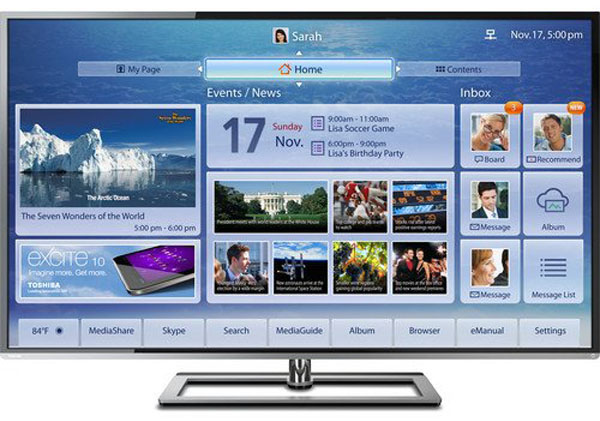Toshiba 50L7300U Review: A 50-Inch LED HDTV With Wi-Fi
You've seen us dramatically increase our display coverage over the last year, and now we're reviewing HDTVs too. Our first screen is Toshiba’s 50-inch L7300U Cloud TV with Wi-Fi. We run it through our lab and usability tests to see how it measures up.
Toshiba 50L7300U Cloud TV: Tons Of Features At A Reasonable Price
The lines between computer monitors and HDTVs are pretty blurry. Aside from the most popular sizes, there aren't many technological differences between the screen on your desk and the TV in your living room. Nearly all desktop displays employ LED backlights. The same is true for large-screen HDTVs (and when I say large, I'm talking about 50 inches-plus).
In the not-so-distant past, a mainstream TV was 32 inches and high-definition meant 720p. Now, enthusiasts seem to start their research at 50 inches, while even the least-expensive models support 1080p.
Always value-conscious, Toshiba recently began shipping its line of Cloud TVs. The company sent over the 50L7300U for us to look at. This is a 50-inch LED edge-lit panel with a full array of network features. In fact, you could watch a tremendous amount of content on it with nothing more than an Internet connection. Selling at a list price of $1400 and a street price under $900, Toshiba's latest might just be a cord-cutter's dream display.
| Brand | Toshiba |
|---|---|
| Model | 50L7300U |
| List Price | $1400 |
| Panel Type | IPS |
| Backlight | W-LED, edge array |
| Screen Size | 49.5" |
| Max Resolution | 1920x1080 |
| Max Refresh Rate | 240 Hz |
| Aspect Ratio | 16:9 |
| Response Time (GTG) | 8 ms |
| Brightness (cd/m2) | 443 |
| Speakers | 2 x 10 W |
| HDMI | 4 |
| VGA | 1 |
| Component | 1 |
| Composite | 2 |
| Audio In | 1 x 3.5 mm, 1 x RCA |
| Audio Out | 1 x 3.5 mm, 1 x optical |
| USB | 2 (v2.0) |
| IR Control | 1 out |
| Panel DimensionsW x H x D | 44.8 x 29.2 x 9.5 in1139 x 742 x 242 |
| Panel Thickness | 2.3 in / 58 mm |
| Weight | 38.4 lbs / 17.4 kg |
| Warranty | One year |
There are a couple of principal differences between HDTVs and computer monitors. First and foremost is that every television includes speakers and some sort of tuner. Believe it or not, those items are required by the FCC before a manufacturer can call its product a television. If they aren't part of the package, the device must be labeled “monitor.” Pioneer's now-discontinued PRO-141 and -151 plasma displays are good examples. They had neither tuner nor speakers, but were clearly marketed as televisions.
Another difference is video processing and scaling. While all fixed-pixel displays scale incoming signals to their native resolutions, HDTVs have more sophisticated video processing abilities used to handle the various cadences and refresh rates that exist in video-based content. This is a vast subject unto itself, and we'll go into more depth on page 11, along with a few tests we’re adding to our benchmark suite.
In addition to the usual image quality tests, which we tweaked somewhat, we’ll cover usability both for traditional content delivered via broadcast and Blu-ray, and streamed video, which the 50L7300U offers in abundance. We're retaining our response and lag tests because we know HDTVs are often the centerpieces for home entertainment. You probably won't connect a high-end gaming PC to this screen, but plenty of folks will hook up an Xbox One or PlayStation 4, we're sure.
Get Tom's Hardware's best news and in-depth reviews, straight to your inbox.
Current page: Toshiba 50L7300U Cloud TV: Tons Of Features At A Reasonable Price
Next Page Toshiba 50L7300U Physical Characteristics
Christian Eberle is a Contributing Editor for Tom's Hardware US. He's a veteran reviewer of A/V equipment, specializing in monitors. Christian began his obsession with tech when he built his first PC in 1991, a 286 running DOS 3.0 at a blazing 12MHz. In 2006, he undertook training from the Imaging Science Foundation in video calibration and testing and thus started a passion for precise imaging that persists to this day. He is also a professional musician with a degree from the New England Conservatory as a classical bassoonist which he used to good effect as a performer with the West Point Army Band from 1987 to 2013. He enjoys watching movies and listening to high-end audio in his custom-built home theater and can be seen riding trails near his home on a race-ready ICE VTX recumbent trike. Christian enjoys the endless summer in Florida where he lives with his wife and Chihuahua and plays with orchestras around the state.
